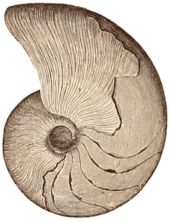Ammonitida
| Ammonitida Temporal range: Jurassic–Cretaceous | |
|---|---|
 | |
| Parapuzosia seppenradensis, the largest known ammonite (diameter 1.8 m) | |
| Scientific classification | |
| Kingdom: | Animalia |
| Phylum: | Mollusca |
| Class: | Cephalopoda |
| Subclass: | †Ammonoidea |
| Order: | †Ammonitida Hyatt 1889 |
| suborders | |
The Ammonitida is an order of more highly evolved ammonoid cephalopods from the Jurassic and Cretaceous time periods, commonly with intricate ammonitic sutures.
The Ammonitida are divided into four suborders, the Phylloceratina, Lytoceratina, Ancyloceratina, and Ammonitina.
The Phylloceratina is the ancestral stock, derived from the Ceratitida near the end of the Triassic. The Phylloceratina gave rise to the Lytoceratina near the beginning of the Jurassic which in turn gave rise to the highly specialized Ancyloceratina near the end of the Jurassic. Both the Phylloceratina and Lytoceratina gave rise to various stocks combined in the Ammonitina.
These four suborders are further divided into different stocks, comprising various families combined into superfamilies. Some like the Hildocerataceae and Stephanocerataceae are restricted to the Jurassic. Others like the Hoplitaceae and Acanthocerataceae are known only from the Cretaceous. Still others like the Perisphinctaceae are found in both.
References
- Arkell, et al., 1957. Mesozoic Ammonoidea; Treatise on Invertebrate Paleontology, Part L, Ammonoidea. Geol Soc of America and Univ. Kansas press. R.C. Moore (Ed).
- Classification of N. H. Landman et al. 2007
| Wikispecies has information related to: Ammonitida |
